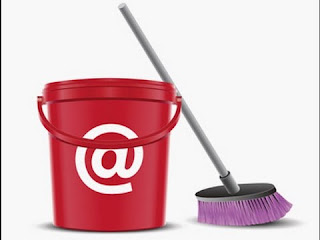In the spirit of spring cleaning, here is some information on
the benefits of performing maintenance on your email marketing lists. This
entails cleaning out inactive contacts from your future email marketing
campaigns. Performing this regularly is a sound strategy to ensure you are only
emailing the people who truly want your messages.

Another point to consider for the time frames listed above is that not all marketing strategies are the same. Companies that send frequently would want to adjust these time frames based on how many emails are being sent. For example, daily email senders should use a smaller window like 30 to 60 days. If you send a monthly newsletter then 120 to 180 days would be more appropriate. It always depends on the business and marketing model, so be cognizant of how often you’re sending and how frequently your contacts are engaging.

What is list hygiene?
Email providers have become smarter and more attuned to what
recipients want to receive in their inbox. This means a clean list is a must
when it comes to getting your emails delivered to the inbox. They are digging
in deep to the emails you’re sending and the engagement recipients are having
with those messages.
Beyond spam complaints, ESPs are calculating opens,
clicks, unsubscribe inactivity and more into the algorithm’s that decide inbox
placement. Once a recipient opts into your content, it is extremely important
to monitor and track behavior over time. Permission to send emails does not
last forever; even the most engaged subscribers can lose interest as time
passes, which can then in turn mean they may be a liability than an asset.
Why should I care what the email providers are doing?
Email providers are a big deal. The
metrics they use to determine inbox placement is your pot of gold as a sender.
It should be a driving force for you to keep the most active and engaged
contacts in your database and it helps in delivering your prospects’ and
customers’ emails to the inbox.
What’s considered Engagement?
- Recent
Opt-ins would be contacts that have opted in to your marketing list, showing a
recent interest in your company’s emails. Please note that a recent opt-in
could be a false or illegitimate address so it is important to ensure
engagement is being tracked, this will help promptly remove those types of
addresses. Another remedy to ensure that a subscriber is who they say they
are, is implementing the beloved email confirmation into your
marketing campaigns.
- Purchasing a product or
subscription isn’t necessarily explicit permission for ongoing email
marketing communication, but often (with proper checkboxes and
confirmations applied) it renders a higher level of engagement. Remember, subscribers
with a valid credit card on file do not necessarily mean they have a valid
email address.
- Once a contact is added to your marketing list, these are two important actions you will want tomonitor over time. While opens are an effective metric, clicks are much more accurate. I say this because an open is tracked by having images enabled and a tracking pixel loaded within the email when it is opened. If images are not displayed or the email is viewed via the preview pane, an open will not be recorded. Just another reason to send highly targeted emails, with a call to action (CTA), to keep your subscribers engaged.

Another point to consider for the time frames listed above is that not all marketing strategies are the same. Companies that send frequently would want to adjust these time frames based on how many emails are being sent. For example, daily email senders should use a smaller window like 30 to 60 days. If you send a monthly newsletter then 120 to 180 days would be more appropriate. It always depends on the business and marketing model, so be cognizant of how often you’re sending and how frequently your contacts are engaging.
By: Sarah Connolly
